story and photos by Kayte Deioma
The number one attraction in the Pasadena area other than the New Years Day Tournament of Roses is the Norton Simon Museum. This museum is home to the extensive works of art collected by industrialist Norton Simon between the 1950s and 1970s. He used some of the wealth he generated from his international consumer products companies to amass an amazing collection of art from Old Masters to contemporary artists. The current Norton Simon collection also includes works from the Pasadena Art Museum, which merged with the Norton Simon in 1974.
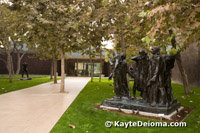 A visit to the Norton Simon begins before you even enter the building. The walkway from the parking lot traverses a garden of larger-than-life Rodin sculptures. The centerpiece of these sculptures is the Burghers of Calais, a sculpture of six men in ragged clothing with nooses around their necks. It was commissioned by the city of Calais to commemorate the brave act of these men in hostaging themselves to the King of England in order to gain freedom for their town in 1347. Before creating the final sculpture of the six men, August Rodin created studies of each individual nude and then clothed. Some of these full-size studies surround the Burghers of Calais in the front garden.
A visit to the Norton Simon begins before you even enter the building. The walkway from the parking lot traverses a garden of larger-than-life Rodin sculptures. The centerpiece of these sculptures is the Burghers of Calais, a sculpture of six men in ragged clothing with nooses around their necks. It was commissioned by the city of Calais to commemorate the brave act of these men in hostaging themselves to the King of England in order to gain freedom for their town in 1347. Before creating the final sculpture of the six men, August Rodin created studies of each individual nude and then clothed. Some of these full-size studies surround the Burghers of Calais in the front garden.
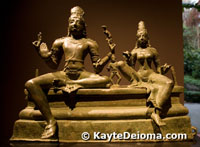 Inside, the Museum is divided into two levels. The main level or upper level houses European and American paintings and sculptures from the 14th century to the 20th century. Downstairs is Norton Simon’s extensive collection of South and Southeast Asian Art, which consists primarily of sculptures and architectural elements from India, Thailand, Cambodia, Tibet and other parts of Southeast Asia with just a few works on paper. The temporary exhibit hall is also downstairs.
Inside, the Museum is divided into two levels. The main level or upper level houses European and American paintings and sculptures from the 14th century to the 20th century. Downstairs is Norton Simon’s extensive collection of South and Southeast Asian Art, which consists primarily of sculptures and architectural elements from India, Thailand, Cambodia, Tibet and other parts of Southeast Asia with just a few works on paper. The temporary exhibit hall is also downstairs.
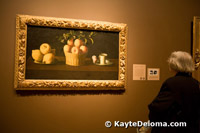 The beauty of the Norton Simon is that you can see virtually every important European artist from the Old Masters to the Impressionists and post-Impressionists all within a few steps of each other. Earlier works on display include Raphael’s Madonna and Child with Book (c.1502-3), Francisco de Zurburan’s Still Life with Lemons, Oranges and a Rose (1633) and Rembrandt van Rijn’s Portrait of a Boy, Presumed to Be the Artist’s Son, Titus (c. 1645-50).
The beauty of the Norton Simon is that you can see virtually every important European artist from the Old Masters to the Impressionists and post-Impressionists all within a few steps of each other. Earlier works on display include Raphael’s Madonna and Child with Book (c.1502-3), Francisco de Zurburan’s Still Life with Lemons, Oranges and a Rose (1633) and Rembrandt van Rijn’s Portrait of a Boy, Presumed to Be the Artist’s Son, Titus (c. 1645-50).
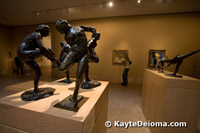 In the popular Impressionists exhibit, you can see Matisse, Renoir, Van Gogh, Manet, Monet, Toulouse-Lautrec, Cezanne and Degas side by side, with multiple examples of each. Vincent van Gogh’s Mulberry Tree is one of the more famous works in the collection, along with the Degas‘ sculpture, Little Dancer, Aged Fourteen (1878-81). The museum has one of the largest collections of works by Edgar Degas, with over 100 paintings, drawings, statues and bronze modčles that the artist used as studies for his dancer figures.
In the popular Impressionists exhibit, you can see Matisse, Renoir, Van Gogh, Manet, Monet, Toulouse-Lautrec, Cezanne and Degas side by side, with multiple examples of each. Vincent van Gogh’s Mulberry Tree is one of the more famous works in the collection, along with the Degas‘ sculpture, Little Dancer, Aged Fourteen (1878-81). The museum has one of the largest collections of works by Edgar Degas, with over 100 paintings, drawings, statues and bronze modčles that the artist used as studies for his dancer figures.
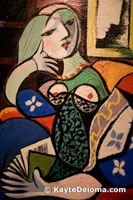 Pablo Picasso, another of the collector’s favorites, dominates the 20th century wing. The museum has 45 of the artist’s sketches, paintings and sculptures. Not all of them are on display at the same time, but the selected works show the diversity of styles Picasso used before developing his signature Cubism. Woman with a Book (1932), one of Picasso’s most recognizable Cubist pieces is presented next to his straightforward pre-cubist oil-and-chalk-on-canvas Bust of a Woman (1923).
Pablo Picasso, another of the collector’s favorites, dominates the 20th century wing. The museum has 45 of the artist’s sketches, paintings and sculptures. Not all of them are on display at the same time, but the selected works show the diversity of styles Picasso used before developing his signature Cubism. Woman with a Book (1932), one of Picasso’s most recognizable Cubist pieces is presented next to his straightforward pre-cubist oil-and-chalk-on-canvas Bust of a Woman (1923).
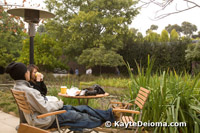 There is a Garden Café and Sculpture Garden at the back of the Main Level. Most of the massive sculptures around the pond are by French artist, Aristide Maillol, including the figure of a woman apparently washing her hair in a river. Unfortunately, they positioned the woman with her hair facing the pond; it’s not in the best position to be viewed from the path.
There is a Garden Café and Sculpture Garden at the back of the Main Level. Most of the massive sculptures around the pond are by French artist, Aristide Maillol, including the figure of a woman apparently washing her hair in a river. Unfortunately, they positioned the woman with her hair facing the pond; it’s not in the best position to be viewed from the path.
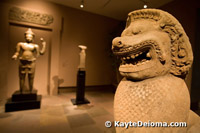 While the paintings and sculptures on the main level have brought the Norton Simon its greatest renown, the lower level also holds abundant treasures. Norton Simon was fascinated by Indian and other South and Southeast Asian antiquities. His collection ranges from the pious to the playful to the erotic as depicted in copper miniatures, cast bronze figures and carved stone statues and architectural features. Gods and goddesses, celestial dancers and amorous couples are the predominant themes. A separate Asian Sculpture Garden is accessible from the Asian galleries on the Lower Level.
While the paintings and sculptures on the main level have brought the Norton Simon its greatest renown, the lower level also holds abundant treasures. Norton Simon was fascinated by Indian and other South and Southeast Asian antiquities. His collection ranges from the pious to the playful to the erotic as depicted in copper miniatures, cast bronze figures and carved stone statues and architectural features. Gods and goddesses, celestial dancers and amorous couples are the predominant themes. A separate Asian Sculpture Garden is accessible from the Asian galleries on the Lower Level.
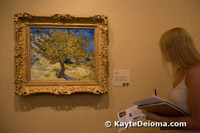 If you have time, take in an orientation film or two in the 300-seat theater. The Art of Norton Simon is a 30 minute film about Norton Simon and his passion for Art. Sister Wendy at the Norton Simon Museum is a delightful tour by the black-robed art scholar, Sister Wendy, of some of the museum’s most famous pieces. The hour-long program created for PBS has been broken into three 20-minute segments for viewing at the museum.
If you have time, take in an orientation film or two in the 300-seat theater. The Art of Norton Simon is a 30 minute film about Norton Simon and his passion for Art. Sister Wendy at the Norton Simon Museum is a delightful tour by the black-robed art scholar, Sister Wendy, of some of the museum’s most famous pieces. The hour-long program created for PBS has been broken into three 20-minute segments for viewing at the museum.
At any given time, 1000 of the 12,000 pieces in the collection are on display at the museum. Even the best known pieces may be rotated out from time to 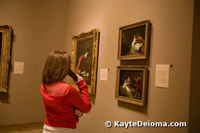 time, so you may not find every painting in the brochure or the videos on the wall when you visit. The paintings are organized by period and by country of origin. The galleries on the main level are all single corridors, so you can go down one side and come back the other and see everything. A self-guided audio tour is available to guide you through the highlights of the exhibit. You dial in the number next to a painting to listen to commentary about it, so you can make the tour as long or short as you like, depending on which pieces you want to hear more about.
time, so you may not find every painting in the brochure or the videos on the wall when you visit. The paintings are organized by period and by country of origin. The galleries on the main level are all single corridors, so you can go down one side and come back the other and see everything. A self-guided audio tour is available to guide you through the highlights of the exhibit. You dial in the number next to a painting to listen to commentary about it, so you can make the tour as long or short as you like, depending on which pieces you want to hear more about.
The Norton Simon Museum
411 West Colorado Blvd.
Pasadena, CA 91105
Phone: (626-449-6840
www.nortonsimon.org
